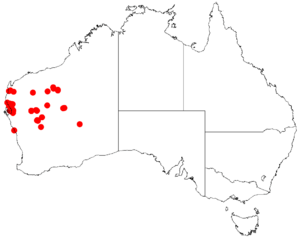Whispering myall facts for kids
Quick facts for kids Whispering myall |
|
|---|---|
| Scientific classification | |
| Genus: |
Acacia
|
| Species: |
sibilans
|
 |
|
| Occurrence data from AVH | |
The Acacia sibilans, also known as the whispering myall, is a type of shrub or tree. It belongs to the Acacia family. This plant is special because it is found only in the dry, central-western parts of Australia. It's a unique part of the Australian landscape.
Contents
What Does the Whispering Myall Look Like?
This bushy plant can grow as a shrub or a tree. It usually reaches a height of about 3 to 7.5 meters (10 to 25 feet). Sometimes, it can look a bit twisted or gnarled. Its bark is rough and has deep cracks.
In some places, these trees can grow even taller, up to 12 meters (39 feet). Their tops, called crowns, can spread out as wide as 15 meters (49 feet). They often have one main trunk that might be crooked. This trunk usually branches out close to the ground.
Leaves and Flowers
When the branches are new, they are a bit hairy. As they get older, they become smooth. Like most Acacia plants, the whispering myall doesn't have true leaves. Instead, it has special leaf-like structures called phyllodes.
These phyllodes are long and thin, like threads. They are a grey-green color. They can be 8 to 18 centimeters (3 to 7 inches) long and about 1 millimeter (0.04 inches) wide. They can be straight or slightly curved. You can see many fine lines running along them.
The whispering myall doesn't flower at a regular time each year. It has been seen flowering in January, April, May, and October. Scientists think it might bloom after heavy rain. When it does flower, it produces round, golden flower-heads. Each flower-head has about 26 to 28 small flowers. These flower-heads grow in small groups of two or three.
Where Does the Whispering Myall Grow?
The whispering myall is found in several regions of Western Australia. These include the Mid West, Gascoyne, Pilbara, and Goldfields-Esperance areas. It often grows on flat areas where rivers have left behind soil. It prefers sandy or loamy soils, especially if there is limestone nearby.
Most of these plants are found in the Gascoyne region. They also grow along the upper parts of the Murchison River. Their range stretches from Shark Bay in the west to an area near Mileura Station in the east.
Other Locations and Plant Neighbors
You can also find smaller, separate groups of whispering myall in the Pilbara region. These are near places like Roy Hill Station and Ethel Creek Station.
In the western areas, the whispering myall often grows with low, bushy plants called chenopodiaceous shrubs. But in the eastern parts, it's more common to find it in scrublands. Here, it grows alongside other Acacia species. These include the Acacia paraneura, Acacia xiphophylla, and Acacia pruinocarpa. It can also be found on flat plains covered with spinifex grass.

